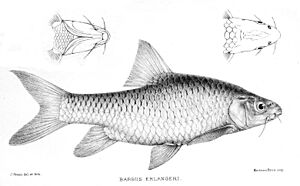Labeobarbus intermedius facts for kids
Quick facts for kids Labeobarbus intermedius |
|
|---|---|
 |
|
| Conservation status | |
| Scientific classification | |
| Synonyms | |
|
Many, see text |
The Labeobarbus intermedius is a type of ray-finned fish found in East Africa. It belongs to the family called Cyprinidae, which includes carps and minnows. This fish is quite large, growing up to almost 50 centimeters (about 20 inches) long. It's related to the yellowfish and has a special genetic feature: it's hexaploid, meaning it has six sets of chromosomes in its cells instead of the usual two.
About Its Name
The Labeobarbus intermedius was first described in 1835. For a long time, many scientists placed it in a large group called Barbus. This group was sometimes called a "wastebin genus" because many different fish species were put into it without clear reasons. However, scientists are now moving this fish back into the Labeobarbus group, which seems like a better fit. It's a close relative of another African fish called Labeobarbus bynni.
Past Names and Relatives
Over the years, this fish has been given many different names, which can be confusing! Here are some of the names it was once known by:
- Barbus erlangeri
- Barbus gregorii
- Barbus intermedius
- Barbus intermedius intermedius
- Barbus intermedius australis
- Barbus intermedius leptosoma
- Barbus intermedius microstoma
- Barbus plagiostomus
- Labeobarbus intermedius australis
- Luciobarbus elongatus
Some fish that were once thought to be subspecies (like different types) of Labeobarbus intermedius are now considered their own separate species. These include L. brevicauda, L. gorgorensis, and L. johnstonii.
Where It Lives
This freshwater fish lives in several countries in East Africa, including Kenya, Tanzania, Uganda, and southern Ethiopia.
Habitats
You can find Labeobarbus intermedius in various rivers and lakes:
- The Kerio, Suguta, Turkwel, and northern Ewaso Ng'iro Rivers, along with their smaller connecting streams.
- Lakes like Lake Baringo, Bogoria, and Turkana, and the rivers that flow into them.
Some old records incorrectly stated that this fish lived in the Tana River or Mara River and Lake Victoria. However, these were mistakes, and the fish found there were actually other species.
Conservation Status
Not much is known about how many Labeobarbus intermedius fish there are or exactly how they live in their environment. However, because they are found in many different places and don't seem to have any major threats right now, the IUCN (International Union for Conservation of Nature) does not consider them to be an endangered fish.


